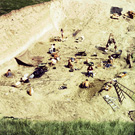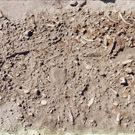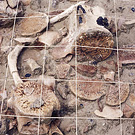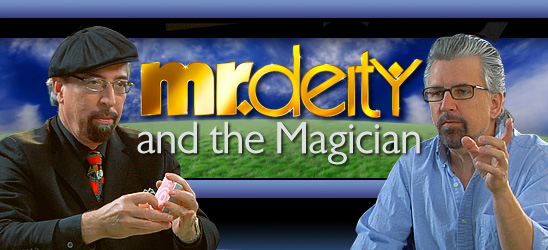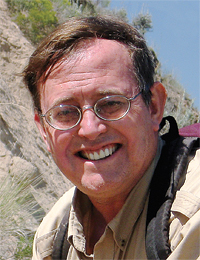In this week’s eSkeptic:
- Help us preserve the Sharktooth Hill Bonebed
- Announcing the Skeptics Mix Tape 2011
- Mr. Deity and the Magician
- Layers of Confusion: Alleged Fraud on Obama’s Long Form Birth Certificate
- MonsterTalk: The Zombie Autopsies
- Science Symposium: Ticket and Scholarship information
- lecture this Sunday: Catastrophes! (by Dr. Donald Prothero)
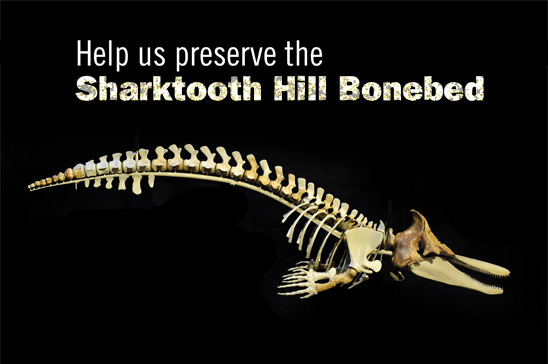
Help us to preserve the Sharktooth Hill Bonebed
This is a special request from Donald Prothero and Teresa LeVelle, your Skeptics Society geology tour leader and coordinator.
We have learned that the world-famous Sharktooth Hill Bonebed fossil locality northwest of Bakersfield, one of the richest and most important sites in the world, is in danger of being sold off to commercial collectors. If this happens, the dealers will excavate it for only the commercially valuable fossils and destroy all the scientific information from the hundreds of sharks, as well as whales and seals and other marine mammals that come from these deposits.
The owner of this land, Bob Ernst (who was a good friend of ours), passed away several years ago suddenly without leaving a will, and his widow is now selling off the fossil-rich property to the highest bidder. Already a lot of important specimens have been sold in auction (including some that were already in a museum collection), and now the Natural History Museum of Los Angeles County is trying to buy one of the most important parcels of Ernst’s property to hold as a scientific preserve (imagine the Page Museum at La Brea Tar Pits, but for marine life). If the museum can raise another $25,000–30,000, they will buy the land. If we collect more than what they need for the land purchase, it will be applied to Phase II of the project, building a visitor’s center. The goal is to preserve the site, while allowing access to schools and non-profit educational groups to help collect the less scientifically significant shark teeth and whale bones. Just imagine that you had been one of the donors who assisted with the acquisition of the La Brea Tar Pits. This is just that type of a once-in-a-lifetime opportunity.
If you would like to make a tax-deductible contribution toward the cause of preserving this legendary locality, please let us know. We must move quickly before the land is sold off and locked away from the public. Dr. John Long of the Natural History Museum has pledged to give a personal tour of the locality, after its purchase, to anyone who donates $2000 or more. You can contact Donald Prothero (Prothero@oxy.edu ) or John Long (jlong@nhm.org ) for more information. Don’t let this opportunity to preserve such an important place for science pass you by. Please help!
Thank you,
Donald Prothero and Teresa LeVelle
CALL FOR SUBMISSIONS
Announcing upcoming Skeptics Mix Tape 2011
to be curated by Desiree Schell of Skeptically Speaking
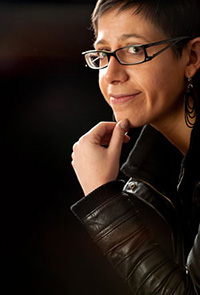
DESIREE SCHELL
photo by Marc Julien Objois
We are pleased to announce the Fall 2011 sequel to our popular Skeptics Mix Tape 2009 and to reveal the curator for the sequel, Desiree Schell (of Skeptically Speaking fame).
The Skeptics Mix Tape is a light-hearted outreach project that gives away selected songs of science and skepticism — what Phil Plait’s Bad Astronomy hailed as “Music to appreciate reality to!” — completely free. This use of the songs is donated by the artists, and the Skeptics Society charges nothing.
The first Skeptics Mix Tape featured twelve artists, including geek-rock superstar Jonathan Coulton, Hard ’n Phirm (the duo of Nerdist Chris Hardwick & Mike Phirman), and acclaimed indy band Artichoke. Canadian artists Dirty Dishes and Coco Love Alcorn recorded tracks especially for the project (with Alcorn’s “Thinking Cap” a completely new song).
The Latest Episode of Mr. Deity
WATCH THIS EPISODE | DONATE | NEWSLETTER | FACEBOOK | MrDeity.com
About this week’s feature article
In this week’s eSkeptic, we present Pat Linse’s debunking of the alleged fraud on Obama’s long form birth certificate.
Pat Linse is the Co-publisher and Art Director of Skeptic magazine. She is the creator of Junior Skeptic, and wrote many of the early issues. She remains its Editor in Chief. She is the Producer for (and contributor to) several Junior Skeptic-based book projects in development. Pat is an award-winning artist with experience in film and advertising.
SUBSCRIBE to Skeptic magazine for more great articles like this one.
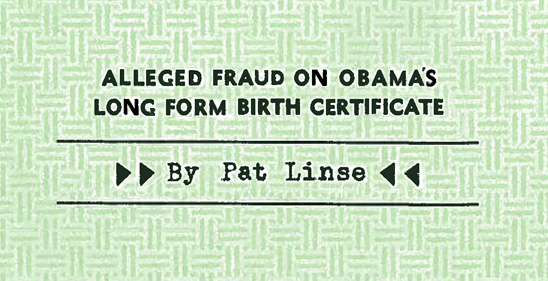
Layers of Confusion: Alleged Fraud on Obama’s Long Form Birth Certificate
Pat’s Maxim: Anything that’s not understood
becomes evidence for conspiracy.
Less than 24 hours after Obama released his long form birth certificate, born-again birthers jumped on the Internet with video “proof” that it was a forgery. Several of these videos show the certificate being processed in two graphic arts programs—Adobe Acrobat and Adobe Illustrator—to reveal dozens of hidden layers in the certificate that supposedly preserved changes made to the original document.
(See this video and this video).
In addition to being separated on individual layers, the supposed changes on the document are identified by anomalies in color, light v. dark tone, and soft blended edges v. sharply pixilated edges. The videos of the birth certificate layers being clicked on and off to a conspiratorial narration of “That’s faked!” … “Obviously faked!” … “Fake! Fake! Fake!” make for compelling viewing.
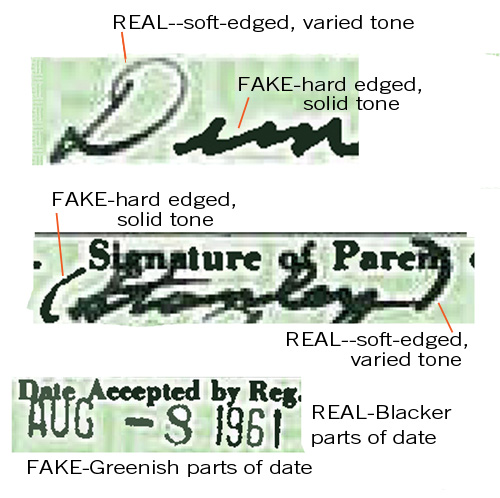
Closeups of the various faked areas called out in one of the videos. These tonal differences were more exaggerated in the video, but I left them as they were in the downloaded Obama certificate.
But even the conspiracy promoters themselves seem dumbfounded by the blatant nature of the alleged fraud and the odd bits of words and numbers that seemed, according to their theories, to have been changed. They consider the anomalies so obvious, sloppy, and “poorly done” that they suspect that the ease by which they have been discovered is also part of the plot. Are the anomalies a “stroke of genius” on the part of a reluctant forger to signal to the outside world that the birth certificate he has been forced to alter is bogus? Did the Obama Administration release an obvious fraud to keep the birther movement alive and draw attention away from more important issues? Or are the powers that be simply thumbing their nose at the American public in an egregious show of disrespect?
There is in fact another explanation besides deliberate fraud for the layers, and the tone and edge anomalies found in the birth certificate.
Graphic Software Sharpening
The first thing anyone looking carefully at the downloaded birth certificate document might notice is the white halo around each of the words on the Obama document. (B.) These are the result of a software manipulation known as “sharpening.” Evidence of sharpening is not evidence of fraud, however. It is a default setting on many scanners and is probably done as a matter of course to increase the readability of the document.

Evidence of sharpening is not evidence of fraud.
Computer sharpening software can not really sharpen an image—it just gives the appearance that the image is sharper by selecting places where two different tones meet and exaggerating the differences between them.
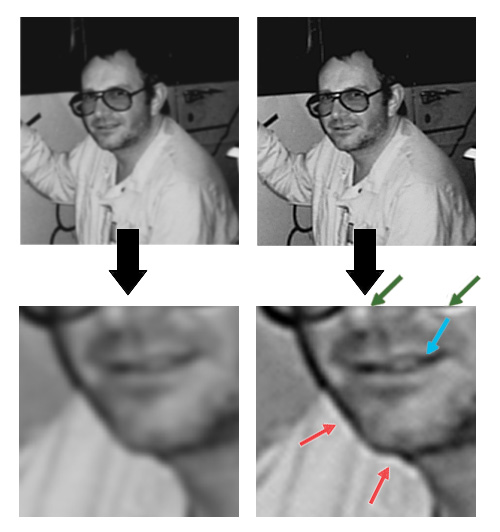
Notice on our example of a sharpened photo (above) how a white halo now accents the side of the face (red arrows) and how highlights (green arrows) and dark areas (blue arrow) have been exaggerated. This accounts for some of the tonal differences between letters on the Obama long form. The sharpening software has made some dark areas darker and some light areas lighter. Sharpening can also exaggerate color differences.
Adobe Optimizing and Optical Character Recognition Software
Ironically, the very Adobe software that the conspiracy theorists used to “reveal” the hidden layers and anomalies is what is actually creating them.
The birth certificates used in this article are both PDF files. There are many kinds and qualities of PDFs, and Adobe has developed some amazing software to help convert one kind to another. Perhaps you have a lengthily document that is only type—you can make a low resolution PDF that will create an easily emailable small file size. But suppose your document has photos that will be unreadable in low resolution—you can use an Adobe software feature called “Optimization” to both reduce your file size but still keep some picture quality. Optimization software has to analyze the image it has been given in order to know what information to keep and what to compress, and the record of this process is recorded in newly generated “layers.”
Another software conversion that generates layers is an ingenious software known as Optical Character Recognition or OCR.
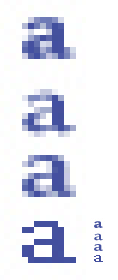
Figure D: pixels
The long form birth certificate file is made of pixels, little squares familiar to anyone who has ever enlarged a photograph on their computer screen, or downloaded a disappointingly low resolution document from the Internet. When seen in closeup, letter forms on this kind of file are clumps of square boxes of different tones (see Figure D, right). When reduced to a tiny size, the eye averages out the tone difference and reads it as a hard-edged letter or number. But most importantly, type on this kind of PDF is essentially only a picture of type. You can’t select and copy sentences from this kind of PDF like you can from a word processing file, and you can’t key stroke in new letters from your keyboard.
Adobe’s Optical Character Recognition software can convert pictures of letters back into real editable type. OCR software is blazingly fast and accurate when converting simple pages of text if the fonts are sharp, clear, and square to the page. But the software has to work a little harder when it takes on a complex document like the Obama long form birth certificate with its background pattern, boxes and lines, and fonts of different tones, shapes and sizes tilted every which way. The program will even take a crack at converting the handwriting. One way the software handles this complexity is by splitting the document up into layers for analysis.
While we can not know exactly what the video makers did to process their copies of the Obama long form birth certificate, an easy way to test the hypothesis that computer processing is creating the layers is to pick a one-layer PDF similar to the file the White House released and run it through the same Adobe programs. (There are a lot of setting options for both OCR and optimization. I will use the manufacturers default settings.) Will new layers be generated? Will tone and edge differences be altered? Our test file will be the one-layer Certificate of Birth released by Donald Trump in PDF format.
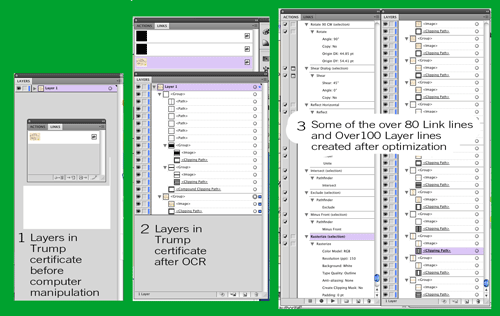
A comparison of the layers generated by the Trump Certificate of Birth under different computer treatments. Download a larger version of the above image.
Above is a comparison of the layers generated by the Trump Certificate of Birth under different computer treatments. Opening the unmanipulated PDF in Adobe Illustrator reveals minimal layering (1). If I open it in Adobe Acrobat and hit the OCR box, and then bring it into illustrator more than a dozen new layers appear (2). If I go back to the unaltered file, and this time ask Adobe to optimize it, and open it in Illustrator I get well over 100 layers. These layers are not a record of forgery—they are a record of what the software did to try to “read” the graphic elements of the file. Download a larger version of the above image to see more detail.
Both operations also produce differences in density and sharpness of pixel edge. Optimizing tends to sharpen the edges while OCR tends to soften them—at least when the default settings are used. (See Figures G and H below)
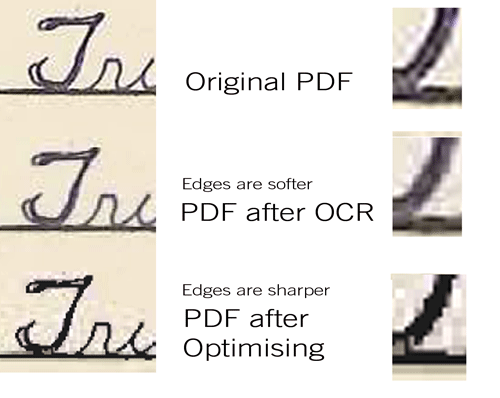
Figure G: comparison of image quality before and after optical character recognition software is used and PDF optimization is applied
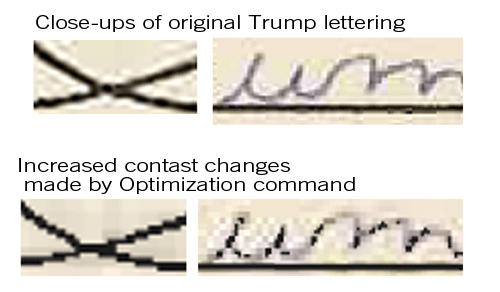
Figure H: contrast increases as a result of the optimization process, which compresses the file size and reduces the image quality
How I would have forged the document
When Michael Shermer first emailed me a link to the layers conspiracy video, I was immediately suspicious of the use of Adobe Illustrator. My first thought as an illustrator was: “Adobe Illustrator is a terrible program to use for that kind of forgery!” Illustrator is what is known as a “vector” program. Its graphic elements are created by mathematical formulas, and it’s best suited for precision line work: graphs, charts, hard-edged flat color design, perfectly smooth gradients, and ornate lettering treatments. It makes crisp, flawless, clean, infinitely high resolution images—hardly the program to use if you are intent on matching a document from the era of the manual typewriter where your changes would have to be dirtied up to match the original.
If I were forging lettering from messy older document that had been scanned and converted to pixels, I’d choose Adobe Photoshop—a “paint” program. As its name implies, it’s for manipulating the pixels of digital photos. In Photoshop I could duplicate all the original irregularities and imperfections of the pixilated typewriter letters with a simple copy/duplicate technique. I could bring the letters up very large on my screen, and jostle a few individual pixels a bit to alter each letter just enough to hide the fact that it was duplicated. I could also be sure by using a slightly altered copy that the pixels defining the edges of the letters would match the original exactly should someone enlarge the document. And instead of the dozens of unnecessary and time consuming layers shown in the conspiracy videos I could make do with just one extra temporary layer to line words up to match the spacing of letters to the original. You can eat soup with a fork, but a spoon is better.

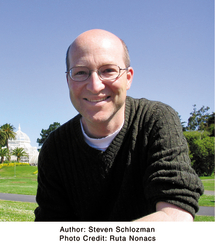
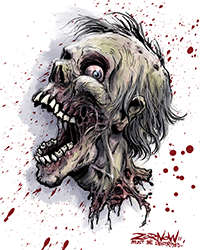
Free download art
by Jeff Zornow
(click image to download 8×10)
The Zombie Autopsies
This week on MonsterTalk, we interview Harvard medical doctor Steven Schlozman, author of The Zombie Autopsies and get inside the walking dead to discuss a plausible mechanism for the zombie apocalypse. It took a lot of guts, but in this episode we discuss:
- How did a doctor become
interested in zombies? - What can zombies teach us
about neurology? - Which is scarier:
infection or cannibalism? - Why don’t zombies have sex?
- What’s the best way to slice a brain?
- What do brains taste like?
- Plus much, much more!
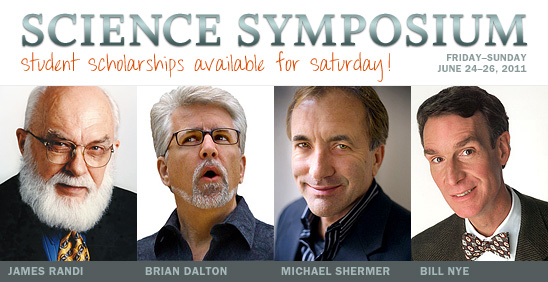
Everyone Welcome
Don’t miss this rare opportunity to hear four of the world’s leading Skeptics discuss their experiences fighting irrationality and promoting science (and what you can do to help)!
Student Scholarships
Full-time college or high school students can apply for a scholarship to attend the Symposium on Saturday, June 25, 2011. Breakfast, lunch and dinner are included; travel and lodging are not included. For high school student scholarship winners, we’ll also cover the entry fee for one chaperone per group of ten students.
Lecture this Sunday
Catastrophes! Earthquakes, Tsunamis, Tornadoes, and Other Earth-Shattering Disasters
with Dr. Donald Prothero
Sunday, May 15, 2011 at 2 pm
Baxter Lecture Hall
DEVASTATING NATURAL DISASTERS HAVE PROFOUNDLY SHAPED HUMAN HISTORY, leaving us with a respect for the mighty power of the earth — and a humbling view of our future. Paleontologist and geologist Donald R. Prothero tells the harrowing human stories behind these catastrophic events:
- The New Madrid, Missouri, earthquakes of 1811–1812 that caused
church bells to ring in Boston - The 2004 Indian Ocean tsunami that killed more than 230,000 people
- The massive volcanic eruptions of Krakatau, Mount Tambora, Mount Vesuvius, Mount St. Helens, and Nevado del Ruiz.
His clear explanations of the forces that caused these disasters accompany gut-wrenching accounts of terrifying human experiences and a staggering loss of life. Floods that wash out whole regions, earthquakes that level a single country, hurricanes that destroy everything in their path — all remind us of how little control we have over the natural world. Order the book on which this lecture is based from Amazon.com.
Ticket information
Tickets are first come first served at the door. Seating is limited. $8 for Skeptics Society members and the JPL/Caltech community, $10 for nonmembers. Your admission fee is a donation that pays for our lecture expenses.
Can’t Make it to Our Lectures?
Get them on DVD!
Many of you would love to be able to make it to our lectures at Caltech, but cannot. And, many of you may not realize that we record almost all of our lectures and sell them on CD and DVD through our online store.


